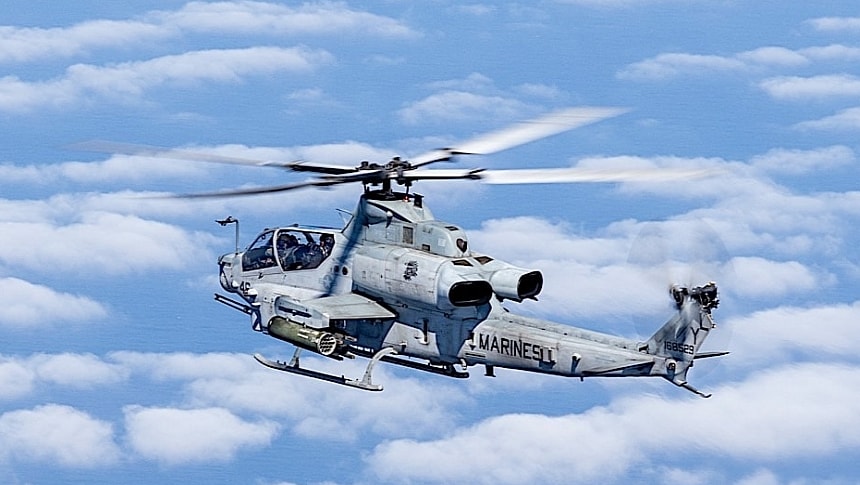As one of the world's major helicopter manufacturers, the Americans from Bell are presently offering several aerial platforms of this kind for the American military, with a few others on the way. But there is little doubt in anybody's mind which of them is at the top of the company's sales charts.
It's a little over two decades since Bell introduced the world to what is perhaps the most vicious-looking present-day attack helicopter, and its equally impressive utility sibling: the AH-1Z Viper and UH-1Y Venom.
The Viper has been designed from the get-go to be hostile to enemies and take them out with all the power provided to it by rotary cannons, rockets, and missiles. It uses a pair of General Electric turboshaft engines to get the job done, flying at speeds of up to 230 mph (370 kph) and for distances that can reach 357 miles (575 km).
The Venom on the other hand, although sharing as much as 85 percent of components with the Viper, is a tad more docile, as its main job is not to fight, but assist, and comes with room for a crew of four and a complement of eight soldiers. This one can reach speeds of 196 mph (315 kph) and distances of up to 374 miles (602 km)...
The two helicopters are primarily used by the American military (more specifically the U.S. Marine Corps), but there are allied nations that field them too. And they are so successful that the combined fleet, counting about 400 examples, managed to pass over half a million flight hours in the summer of last year.
That also means the rotor aircraft are getting old and in need of some serious upgrades. And that's exactly what they're getting, with the most important modification targetting their electrical systems.
Following the completion of the U.S. Marine Corps Program of Record in November 2022, the two helos are on track to "start the next chapter" in their life. That's what Bell calls a modernization effort, better known as the Structural Improvement Electrical Power Upgrade (SIEPU).
The upgrade consists of an undisclosed increase in the helicopters' power capacity, but also the "integration of additional cabin capabilities." It should provide a series of improvements to mission profiles, aircrew safety, and interoperability.
As per Bell, the SIEPU upgrade will also impact the weapon systems of the two helicopters. After getting it, the Vipers and Venoms in the sky should be capable of fielding long-range munitions, air-launched effects, and "new non-kinetic capabilities" of an undisclosed nature.
All the new weapons should give the helos an extended strike range and standoff distance, but more importantly, they should provide a way of fighting airborne drones.
Bell announced this week the first AH-1Z to receive the upgrade was delivered at the company's Amarillo Assembly Center in Texas. Once the entire fleet receives the improvements, the lives of both the Viper and the Venom should be extended well into the 2040s.
The Viper has been designed from the get-go to be hostile to enemies and take them out with all the power provided to it by rotary cannons, rockets, and missiles. It uses a pair of General Electric turboshaft engines to get the job done, flying at speeds of up to 230 mph (370 kph) and for distances that can reach 357 miles (575 km).
The Venom on the other hand, although sharing as much as 85 percent of components with the Viper, is a tad more docile, as its main job is not to fight, but assist, and comes with room for a crew of four and a complement of eight soldiers. This one can reach speeds of 196 mph (315 kph) and distances of up to 374 miles (602 km)...
The two helicopters are primarily used by the American military (more specifically the U.S. Marine Corps), but there are allied nations that field them too. And they are so successful that the combined fleet, counting about 400 examples, managed to pass over half a million flight hours in the summer of last year.
That also means the rotor aircraft are getting old and in need of some serious upgrades. And that's exactly what they're getting, with the most important modification targetting their electrical systems.
Following the completion of the U.S. Marine Corps Program of Record in November 2022, the two helos are on track to "start the next chapter" in their life. That's what Bell calls a modernization effort, better known as the Structural Improvement Electrical Power Upgrade (SIEPU).
The upgrade consists of an undisclosed increase in the helicopters' power capacity, but also the "integration of additional cabin capabilities." It should provide a series of improvements to mission profiles, aircrew safety, and interoperability.
As per Bell, the SIEPU upgrade will also impact the weapon systems of the two helicopters. After getting it, the Vipers and Venoms in the sky should be capable of fielding long-range munitions, air-launched effects, and "new non-kinetic capabilities" of an undisclosed nature.
All the new weapons should give the helos an extended strike range and standoff distance, but more importantly, they should provide a way of fighting airborne drones.
Bell announced this week the first AH-1Z to receive the upgrade was delivered at the company's Amarillo Assembly Center in Texas. Once the entire fleet receives the improvements, the lives of both the Viper and the Venom should be extended well into the 2040s.


































